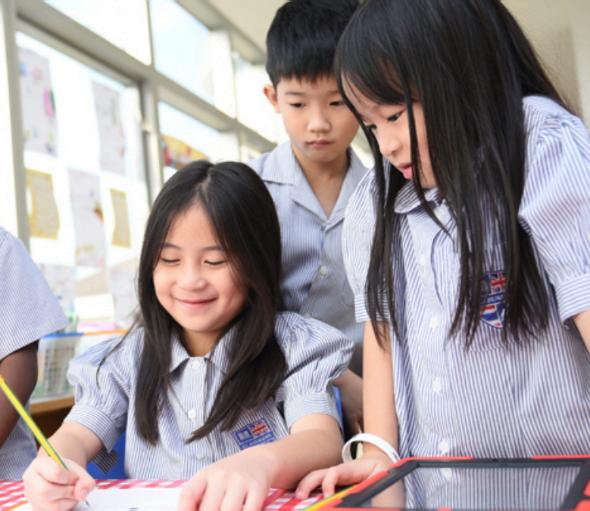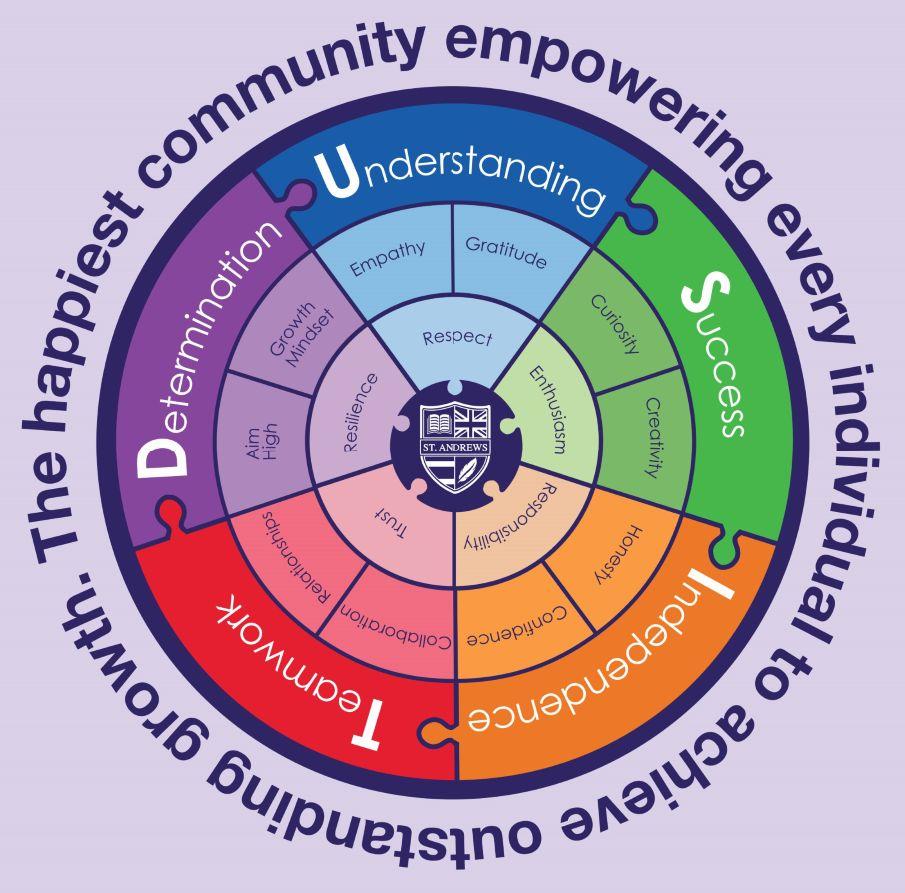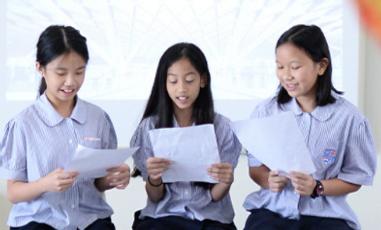Key Stage 2 Curriculum Year 3

(English, Maths and Topic)

Our Vision:
To be the happiest community empowering each individual to achieve outstanding growth.

Our Values:
Aside from our academic curriculum, we are dedicated to supporting our pupils in becoming globally responsible citizens. Our ‘Dusit Values’
(Determination, Understanding, Success, IndependenceandTeamwork) are central to our commitment to ‘character education’, as these aim to give our pupils an understanding of global issues, whilst encouraging and empowering them to take action and promote positive change

An English Curriculum in an International Context

Our curriculum, (based on the British National Curriculum) encompasses a rich blend of academic skills and rigor, whilst skillfully weaving in exciting opportunities for character and outdoor education We believe that putting a spotlight on pupil wellbeing, community projects and sustainability, gives our students all the necessary tools to embrace this rapidly changing world. Pupils are encouraged to become ‘21st century learners’, as we put a great deal of emphasis on creativity, collaboration, communication and critical thinking. We ensure that students get the chance to see the impact of their efforts come to life, through meaningful, motivating project-based learning Our curriculum is carefully designed and regularly audited, to make sure that pupils are active learners, working on solving genuine, real problems and becoming agents of positive change.

KS2 Year 3 Timings

In Key Stage 2, pupils study the majority of their lessons with their class teacher There are also a range of specialist lessons (highlighted below) which are delivered by our specialist teaching team.
There are 30 periods of 50 minutes (or equivalent) a week. Children in Key Stage 2 study the following:
English 5 periods a week Maths 5 periods a week Guided Reading 2 periods a week Project-based learning 2 periods a week Thai language & Cultural studies 3 periods a week World Languages (Mandarin/French/German/Extra Thai) 2 periods a week Science 2 periods a week PSHE (Personal/Social/Health education) 1 period a week Computing 1 period a week Art 1 period a week Spelling 1 period a week Library 1 period a week Music 1 period a week PE (Physical Education) 1 period a week Swimming 1 period a week
In English, we adapt the National Curriculum for England to suit our international context From Years 1-6, we focus on teaching the four main areas of English: reading, writing, speaking and listening.


At Dusit, we recognise that the skill of reading is required to access all areas of the curriculum, therefore a passion and love for reading is something we strive to instil in all our pupils We use carefully selected, high-quality texts to plan and deliver our lessons. This helps to expand our children’s vocabulary and deepen their understanding of the mechanics of the English language. Our chosen texts provide an excellent scaffold for all children to access, encouraging them to view themselves as aspiring authors.
English is often also embedded in our project-based learning, as this approach creates many opportunities for our children to write for a purpose, using an engaging and challenging stimulus.
English
➤ Year 3 English Progression of Skills
Writing:
● Produce work which is organised, imaginative and clear (e.g. simple opening and ending)
● Use a range of chosen forms appropriately and consistently
● Structure and organise work clearly (e.g. beginning, middle, end; letter structure; dialogue structure)
● Adapt their form and style for purpose/audience.
● Develop characters and describe settings, feelings and/or emotions, etc
● Develop and extend ideas logically in sequenced sentences.
● Begin to develop a sense of pace Use adjectives and adverbs for description.
● Begin to use interesting and ambitious words above age expectation

● Link and relate events, including past, present and future.
● Link and relate events, including past, present and future
● Extend sentences using a wider variety of connectives to clarify relationships between points and ideas.
● Begin to use paragraphs
● Use correct grammatical structures in sentences.
● Use most simple punctuation accurately, including at three of the following; full stop and capital letters, question mark, exclamation mark, comma, apostrophe.
● Use pronouns appropriately to avoid the awkward repetition of nouns
● Attempt to give opinion, interest or humour through detail.
● Use generalising words for style (e g sometimes, never, always, often, mainly, mostly, generally, etc.) and/or modal verbs/the conditional tense (e.g. might do it, could rain, should win)
● Spell phonetically regular or familiar common polysyllabic words accurately.
● Join their handwriting.
PunctuationandGrammar:
Sentence:
● Vary long and short sentences: long sentences to add description or information and short sentences for emphasis and making key points
● Use embellished simple sentences Use adverb starters to add detail.
● Use adverbial phrases used as a ‘where’, ‘when’ or ‘how’ starter (fronted adverbials).
● Use prepositional phrases to place the action.
● Use compound sentences (coordination) using connectives: and/or/but/so/for/nor/yet (coordinating conjunctions).
● Develop complex sentences (subordination) with a range of subordinating conjunctions
● Use ‘ing’ clauses as starters
● Drop in a relative clause using: who/whom/which/whose/that
● Use sentence of 3 for description
● Use pattern of 3 for persuasion
● Use topic sentences to introduce nonfiction paragraphs
● Use dialogue –powerful speech verb.
Word:
● Use prepositions.
● Use powerful verbs.
● Use more specific / technical vocabulary to add detail.
● Use nouns formed from prefixes
● Develop word families based on common words
● Use determiners ‘a’ or ‘an’
Punctuation:
● Use a colon before a list.
● Use full punctuation for direct speech: each new speaker on a new line.
● Use a comma between direct speech and reporting clause.
● Use an apostrophe to mark singular and plural possession.

Reading:
● Prepare poems and play scripts to read aloud and to perform, showing understanding through intonation, tone, volume and action.
● Recognise some different forms of poetry.
● Check that the text makes sense to them, discussing their understanding and explaining the meaning of words in context
● Ask questions to improve their understanding of a text
● Identify main ideas drawn from more than one paragraph and summarising these
● Draw inferences such as inferring characters’ feelings, thoughts and motives from their actions.
● Justify inferences with evidence.
● Predict what might happen from details stated and implied.
● Discuss words and phrases that capture the reader’s interest and imagination.
● Identify how language, structure, and presentation contribute to meaning.
● Participate in discussion about both books that are read to them and those they can read for themselves, taking turns and listening to what others say
● Retrieve and record information from non fiction
SpeakingandListening:
(Thesestatementsapplytoallyears Thecontentshouldbetaughtatalevelappropriatetotheageofthechildren Children shouldbuildontheorallanguageskillsthathavebeentaughtinprecedingyears)
● Listen and respond appropriately to adults and their peers.
● Ask relevant questions to extend their understanding and knowledge.
● Ask relevant strategies to build their vocabulary.
● Articulate and justify answers, arguments and opinions.
● Give well-structured descriptions, explanations and narratives for different purposes, including for expressing feelings.
● Maintain attention and participate actively in collaborative conversations, staying on topic and initiating and responding to comments
● Use spoken language to develop understanding through speculating, hypothesising, imagining and exploring ideas
● Speak audibly and fluently with an increasing command of Standard English
● Participate in discussions, presentations, performances, role play/improvisations and debates.

● Gain, maintain and monitor the interest of the listener(s).
● Consider and evaluate different viewpoints, attending to and building on the contributions of others.
● Select and use appropriate registers for effective communication.
Maths
At Dusit, we aim to provide a depth of learning that enables all children to develop a full conceptual understanding of Maths, rather than to merely memorise abstract solutions.

We follow the English National Curriculum, but have adapted it to the needs of our children, providing greater opportunities for mastery We understand that children have different abilities, but instead of driving the more able forward, with a fleeting abstract knowledge, we encourage them to look deeper We provide a variety of challenges labelled as ‘tricky, trickierandtrickiest ’ , in order to make sure that each child is working at an appropriate level of challenge. Our teachers strive to create investigators, always seeking to extend their understanding.
We want our pupils to enjoy the experience of acquiring new number concepts, and realise that It is not about how quickly they get there, but the depth of understanding they experience along the way.

➤ Year 3 Maths Progression of Skills
Numberandplacevalue:
● Count from 0 in multiples of 4, 8, 50 and 100; find 10 or 100 more or less than a given number
● Recognise the place value of each digit in a three-digit number (hundreds, tens, ones).
● Compare and order numbers up to 1000.
● Identify, represent and estimate numbers using different representations.
● Read and write numbers up to 1000 in numerals and in words.
● Solve number problems and practical problems involving these ideas.
Addition, Subtraction, MultiplicationandDivision:
● Add and subtract a three-digit number and ones mentally
● Add and subtract a three-digit number and tens mentally

● Add and subtract a three-digit number and hundreds mentally
● Add and subtract numbers with up to three digits, using formal written methods of columnar addition and subtraction.
● Estimate the answer to a calculation and use inverse operations to check answers.
● Solve problems, including missing number problems, using number facts, place value, and more complex addition and subtraction.
MultiplicationandDivision:
● Recall and use multiplication and division facts for the 3, 4 and 8 multiplication tables
● Write and calculate mathematical statements for multiplication and division using the multiplication tables that they know, including for two-digit numbers times one-digit numbers, using mental and progressing to formal written methods
● Solve problems, including missing number problems, involving multiplication and division, including positive integer scaling problems and correspondence problems in which n objects are connected to m objects.
Fractions:
● Count up and down in tenths; recognise that tenths arise from dividing an object into 10 equal parts and in dividing one-digit numbers or quantities by 10

● Recognise, find and write fractions of a discrete set of objects: unit fractions and non-unit fractions with small denominators
● Recognise and use fractions as numbers: unit fractions and non-unit fractions with small denominators
● Recognise and show, using diagrams, equivalent fractions with small denominators.
● Add and subtract fractions with the same denominator within one whole [for example, 5/7 (five over seven) + 1/7 (one over seven) = 6/7 (six over seven)].
● Compare and order unit fractions, and fractions with the same denominators Solve problems that involve all of the above.
Measurement:
● Measure, compare, add and subtract: lengths (m/cm/mm); mass (kg/g); volume/capacity (l/ml)
● Measure the perimeter of simple 2-D shapes
● Add and subtract amounts of money to give change, using both £ and p in practical contexts.
● Tell and write the time from an analogue clock, including using Roman numerals from I to XII, and 12- hour and 24-hour clocks.
● Estimate and read time with increasing accuracy to the nearest minute; record and compare time in terms of seconds, minutes and hours; use vocabulary such as o’clock, a.m./p.m., morning, afternoon, noon and midnight.
● Know the number of seconds in a minute and the number of days in each month, year and leap year
● Compare durations of events [for example to calculate the time taken by particular events or tasks]
Geometry:
● Draw 2-D shapes and make 3-D shapes using modelling materials; recognise 3-D shapes in different orientations and describe them
● Recognise angles as a property of shape or a description of a turn.
PositionandDirection:

● Identify right angles, recognise that two right angles make a half-turn, three make three quarters of a turn and four a complete turn; identify whether angles are greater than or less than a right angle.
● Identify horizontal and vertical lines and pairs of perpendicular and parallel lines
Statistics:
● Interpret and present data using bar charts, pictograms and tables
● Solve one-step and two-step questions [for example, ‘How many more?’ and ‘How many fewer?’] using information presented in scaled bar charts and pictograms and tables.
Topic
At Dusit, we believe in a creative curriculum where the skills below are interwoven between subjects Each term children's learning will be framed by a theme or topic and they will then get to apply the skills below through cross-curricular activities where the child is at the centre of their own learning journey.
➤ Year 3 Topic - Progression of Skills
Skills Coverage - History Skills Coverage - Geography
Recognise that the past can be divided into different periods of time
Use dates and terms
Analyse a change from the past.
Identify some of the different ways in which the past is represented.
Use sources of information to answer questions about the past
Compare how ancient civilization is different from modern times.
Describe and compare the physical and human features of different localities
Explain the locations of some physical and human features
Draw maps using a key and symbols
Use globes, atlases and maps to find out about places.
Use skills and sources of evidence to respond to a range of geographical questions, and begin to use appropriate vocabulary to communicate their findings
Environmental Education Coverage
Compare the lifestyles of people around the world and reflect on how they are different or the same
Discuss how things are different or similar for people from different backgrounds and identify why this is.

Recognise that there are reasons why people in the past acted as they did
Analyse the human impact of a local environment
Identify how some changes impact on the environment.
Plan for and undertake conservation activities such as tree planting.
Parent Involvement


In addition to the exciting events that take place throughout the year to enrich our curriculum such as International Week, Book Week, Science Week and many more, parents will also be invited into school regularly to see what the children have been learning, to hear presentations and celebrate their child’s work
We will also be holding half-termly #keepingupwiththekids workshops for parents so that they can be kept up to speed on how they can best support their child’s learning journey Parents are also encouraged to volunteer and read with students in the library during the week.








